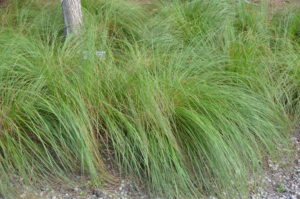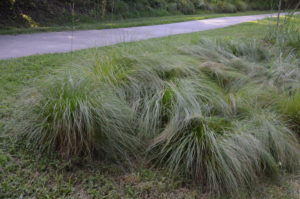Prairie dropseed (Sporobolus heterolepsis) is one of the finest warm season grasses native to the Western U.S. (USDA hardiness zones 3 to 9). Initially, this clump-forming perennial grass grows at a slow to medium rate. By early summer its fine textured deep green leaves form an arching fountain habit. Prairie dropseed inhabits prairies, meadows, open ground, and along railroads.
Clump develops into a mound an average of 2-3 feet tall and wide. By late summer, loose, airy, tan colored inflorescences emerge on 2-3 feet tall spikes along with its unique fragrance. Some report that it smells like coriander, cilantro, or popcorn. By late October the foliage turns russet color and in winter to light bronze.
Prairie dropseed excels in hot, dry conditions where it can really soak up the sun. This grass is exceptionally drought tolerant and is tolerant of soils with low fertility. Initially slow to establish, new plants may be started from seed, although it does not freely self-seed in a garden.
No serious insect or disease problems trouble this native grass. Deer generally leave it alone. Its deep fibrous rootsystem provides exceptional soil erosion control and it resistant to air pollution.
‘Tara’ is a dwarf selection from Roy Diblik. Tara grows slower than the species and has a more upright v-shape habit; leaf blades take on a golden to pumpkin orange color in fall. Utilize it to edge front of beds and borders and in rock gardens. It is beautiful in mass plantings such as meadows. In fall, foliage turns a rust-red color, and seeds provide food for birds.
Landscape use: grow it for its architectural form or as a tall groundcover, or in rock, prairie, meadow, and rain gardens. Annual maintenance is minimal. Cut back old clumps and you may opt to fertilize lightly with 10-10-10 or equivalent in early spring.



 Posted in
Posted in 
